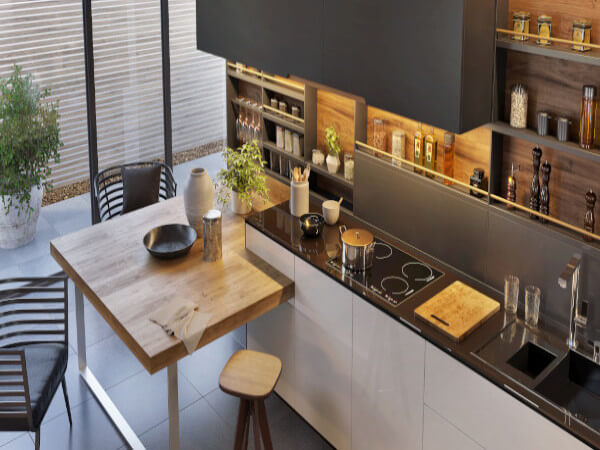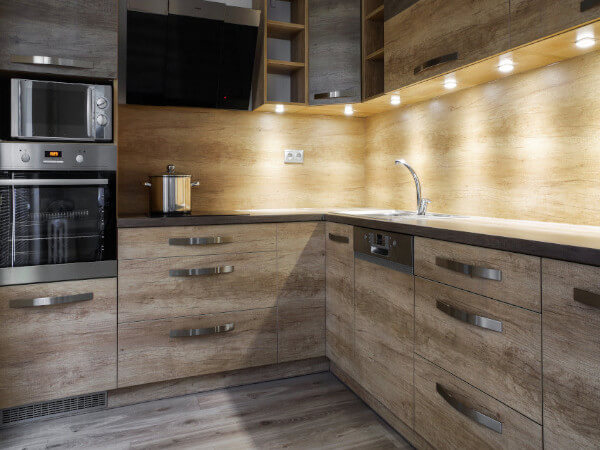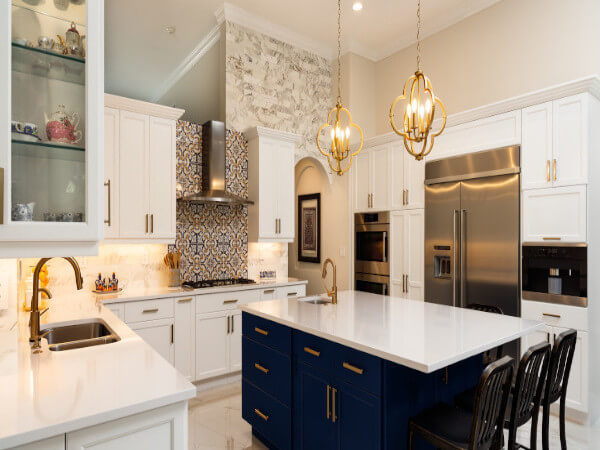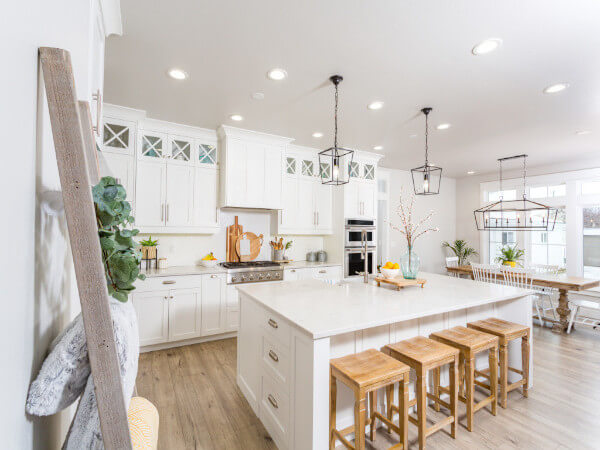Home » Kitchen Services (Page 5)
Category Archives: Kitchen Services
Re-Bath Parent Acquired by Private Equity Firm

PHOENIX — Home Brands Group Holdings Inc., the parent holding company of Re-Bath, the nation’s largest bathroom remodeling franchise, has been acquired by TZP Group LLC, a New York-based private equity firm, and a group of co-investors, the company announced. Financial details of the transaction were not disclosed.
“We are thrilled to partner with Re-Bath and its terrific management team, serving a group of committed franchisees across the U.S.,” said Vlad Gutin, a partner at TZP.
“Re-Bath complements our growing portfolio of leading consumer brands (and) we believe that Re-Bath’s unique, high-quality service offering, loyal customers, best-in-class products of leading brands and partnerships with premier, national retailers, coupled with TZP’s relationships and resources, can accelerate Re-Bath’s growth,” Gutin added.
Re-Bath, headquartered in Phoenix, operates more than 100 locations across North America, according to the company, which offers complete bathroom remodels, tub and shower updates, plus aging and accessibility solutions.
“We are excited to embark on our next chapter of growth with TZP’s investment representing a strong validation of the growth and success we’ve achieved and where we are headed,” said Re-Bath CEO, Brad Hillier. “Through this investment, we will be able to leverage TZP’s expertise and resources to further expand our brand to a wider audience and better serve our customers, franchisees, partners and employees.”
The post Re-Bath Parent Acquired by Private Equity Firm appeared first on Kitchen & Bath Design News.
Flexible Design in the Kitchen

Today’s kitchens are delivering more multi-tasking than ever, as islands and niches now act as places to do homework, bill-paying and game playing in addition to eating breakfast and entertaining. Function remains vital to the way a kitchen is designed, and as lifestyles change, so do the elements of the overall space.
In addition to multifunctionality, trends impacting kitchen design include advancing technology and wellness. Aesthetically, color is upping its presence in appliances, tile and countertops, so cabinets need to provide the right complement – whether that means a striking, bold selection or calm, neutral backdrop.
Key trends impacting the kitchen cabinet segment include:
–The selection of flexible and specialized storage features continues to expand as homeowners try to make use of every inch of space in the kitchen.
–Wood tones are making a comeback, with finishes ranging from pale, natural wood looks to rich, dark grayed browns.
–Texture continues to trend, with weathered woods and soft-touch options among the most popular.
–The interest in color is skyrocketing, with painted and powder-coated finishes now available in an almost endless selection.
–Among the most popular colors trending for cabinets are blues and greens with a hint of gray, as well as black and, of course, white.
–Creative storage for cabinets includes pullouts, peg systems, pull-downs and blind-corner options, while drawers feature dividers and elegant organization for utensils and other items.
The post Flexible Design in the Kitchen appeared first on Kitchen & Bath Design News.
Did you miss our previous article…
https://anekitchencabinets.com/?p=322
EPA Ruling Caps Production of HFCs in Refrigeration

WASHINGTON, DC — In what officials are calling a major step in combating global climate change, the U.S. Environmental Protection Agency has issued a final rule establishing a program to cap and phase down domestic production and consumption of climate-damaging hydrofluorocarbons (HFCs), highly potent greenhouse gases commonly used in refrigerators and air conditioners.
The landmark program, announced today, will phase down the U.S. production and consumption of HFCs by 85% over the next 15 years, as mandated by the American Innovation and Manufacturing (AIM) Act, enacted in December 2020 as part of an effort designed to slow global warming, EPA officials said. HFCs are potent greenhouse gases commonly used in refrigeration and air conditioning equipment, as well as foams and other applications.
The bipartisan AIM Act, backed by a coalition of industry and environmental groups, not only phases down HFCs, but also ushers in the use of more climate friendly and energy-efficient alternatives aimed at saving consumers money while protecting the environment, according to the EPA.
“Today, EPA is taking a significant step forward to tackle the climate crisis,” said EPA Administrator Michael Regan. “Cutting these climate ‘super pollutants’ protects our environment, strengthens our economy, and demonstrates that America is back when it comes to leading the world in addressing climate change and curbing global warming in the years ahead.”
“American companies are at the forefront of developing HFC alternatives and the technologies that use them, and the AIM Act provides these companies additional opportunities to continue to innovate,” Regan added.
EPA estimates that the cumulative net benefit of its action will amount to more than $272 billion from 2022 through 2050, and that the rule will yield cumulative compliance savings for industry. In 2036 alone, the year the final reduction step is made, the rule is expected to prevent emissions of the equivalent of 171 million metric tons of carbon dioxide (CO2) – roughly equal to the annual greenhouse gas emissions from one out of every seven passenger vehicles registered in the U.S., the EPA said. The total emission reductions of the rule from 2022 to 2050 are projected to amount to the equivalent of 4.6 billion metric tons of CO2 – nearly equal to three years of U.S. power sector emissions at 2019 levels.
EPA officials said the agency will work with the U.S. Dept. of Homeland Security to prevent the illegal import and trade of HFCs through an interagency task force led by personnel from U.S. Customs and Border Protection, U.S. Immigration and Customs Enforcement, Homeland Security Investigations and EPA.
The post EPA Ruling Caps Production of HFCs in Refrigeration appeared first on Kitchen & Bath Design News.
Did you miss our previous article…
https://anekitchencabinets.com/?p=319
Sustainability Seen Shaping Housing, Remodeling Markets

INDIANAPOLIS, IN — A trio of emerging trends in neighborhood design and sustainable living practices should continue to shape the market for new housing and residential remodeling as the “mindset of consumers continues to shift in a dynamic social climate,” according to a new report from the Home Improvement Research Institute.
According to HIRI’s recently issued Future of Housing Trend Report, new and remodeled homes will likely be shaped by a growing homeowner passion regarding issues such as climate change, sustainability and minimalism, resulting “in an increased emergence of eco-friendly materials and 3D-printed technology to designs focused on cultural inspiration and reversible architecture.”
Among the key trends identified by HIRI researchers are the following:
n “Hyper-local neighborhoods”: Architects, developers and local governments are proposing neighborhoods centered on community building and local businesses. These spaces are intended to be car-free, with all necessities reachable via a short walk or bicycle ride.
n Flight from the cities: “As urban centers expand in size and population, consumers are recognizing that their quality of life is suffering — whether that be due to alienation, affordability issues, lengthy commutes or pollution,” HIRI said. As a result, many are moving away from city centers and turning to community-based neighborhoods that provide a sense of belonging while also satisfying the need for convenience and cleaner air.
n Sustainable Housing: With sustainability as a top priority, architects and designers are embracing different eco-friendly concepts, among them “reversible design” (the architecture of structures that can be easily deconstructed, that can be reused or with parts that can be removed and added easily) and 3D-printed housing (homes that offer sustainable and protective construction that avoids structural issues in the case of extreme weather).
“Contemporary consumers are wary of the impending consequences of climate change, and a large number are becoming increasingly aware that simply shifting their lifestyle and practicing ecological mindfulness are likely not enough,” HIRI said. “As a result, many are demanding that brands and creators take the environment into consideration.
n Simplified Living: Building off of the desire for more sustainable living, the emergence of simple, more minimalist design emphasizes homeowners’ functions and needs.
“Contemporary consumers in fast-paced urban centers are looking to balance the demands of their daily lifestyle with a comfortable home environment,” HIRI said. “Many are prioritizing minimalist designs and additional spaces that can optimize and elevate their living situation without compromising aesthetic appeal.”
The post Sustainability Seen Shaping Housing, Remodeling Markets appeared first on Kitchen & Bath Design News.
Todd Atkins

As the kitchen designer of The 2021 New American Home, Todd Atkins, senior kitchen designer for the Phil Kean Design Group, in Winter Park, FL, showcased his mastery in mixing unexpected styles and aesthetics to create a leading-edge, yet classic kitchen design that is ahead of its time. This “modern” kitchen showcases soft, warm tones and a balance of modern and traditional elements that work together to achieve a high-end, sophisticated setting.
For example, a traditional 10′ walnut hutch acts as the anchor of this modern kitchen, recessed into the 14′ wall and surrounded floor-to-ceiling with a soft white quartz. The refrigerator/freezer and pantry are hidden behind a high-gloss, champagne-colored panel wall, framed in a carbon-stained 8″ Alder wood surround. The surround is duplicated on the range wall that blends classic inset base units painted in cream with mirrored upper cabinetry and a custom hood in chevron walnut panels with bronze metal trim. Then, kitchen finishes are rounded out with a gold faucet, refrigerator pulls in gunmetal, brushed nickel sconces, silver island pendant and gold pulls on the range wall cabinetry and on the walnut hutch.
The seasoned interior architect and designer’s new take on combining finishes and textures is exciting innovation in kitchen design, note colleagues.
The post Todd Atkins appeared first on Kitchen & Bath Design News.
Did you miss our previous article…
https://anekitchencabinets.com/?p=265
The Invisible Workplace Crisis
There’s little doubt that COVID-19 has radically transformed the residential remodeling, housing and kitchen/bath landscape.
For one thing, remodeling demand is reportedly at record highs, with both short- and long-term forecasts overwhelmingly positive. At the same time, new lifestyles emerging as byproducts of the global pandemic are proving responsible for the current mindset driving home design, product preferences and consumer purchases. Homes have literally been transformed, doubling in many cases as offices, schools, playgrounds and multi-generational residences. Wellness, sanitization, biophilic design and an emphasis on outdoor living have become more pronounced than ever. Multi-functional kitchens and eco-inspired baths remain high on the list of remodeling projects favored by homeowners.
But there’s more to the impact of the coronavirus than simply that.
Businesses on every rung of the product-distribution chain have been forced in the past 18 months to essentially reinvent themselves, implementing virus-mitigation strategies ranging from masking and showroom protocols to an increased emphasis on remote employees and digital-connectivity tools. Product costs have risen sharply, while labor shortages have been exacerbated and supply chain disruptions continue to result in project delays. Home prices have also spiked amidst shrinking inventories and a pronounced flight from the cities.
And now there’s yet another COVID-related issue that’s increasingly impacting the residential construction trade: the profound impact that the public-health crisis is having on workplace mental health.
Indeed, throughout the months-long pandemic, employees and business owners alike have faced an unprecedented confluence of issues threatening their physical and mental wellbeing. Routines have been disrupted, relationships strained, fears heightened over personal health and the health of loved ones. Feelings of isolation have led, in many cases, to a pervasive sense of loneliness and vulnerability. Anxiety, uncertainty, depression and stress have similarly taken a toll. While many remote employees are handling the disruptions well, others miss the sense of connectedness they had once in offices, factories and showrooms.
The subject of workplace mental health has been thrust into the public spotlight in recent months, particularly now that the nation is experiencing a resurgence of the coronavirus amidst contentious differences regarding issues like masking and vaccinations. And now, with no end to the pandemic seemingly in sight, many people are experiencing a sense of “horizonlessness,” the lack of a firm reference point regarding the future, as well as a sense of déjà vu regarding potential job losses and business closures.
All of this has had a cumulative effect. Indeed, workplace mental health is being described by experts as an “invisible crisis” that has yielded a palpable rise in chronic pain, fatigue, substance abuse, loss of productivity and suicide.
It has also yielded, thankfully, some decisive action.
The National Association of Home Builders, for example, is actively attempting to change the culture regarding mental health awareness by providing resources tailored to employees and business owners in the residential construction trade. As evidence, the NAHB recently launched a multi-faceted initiative focused on helping business owners support healthy work environments and turn mental health awareness into action. As part of that effort, the NAHB partnered with other trade groups and mental-health experts to develop specific tools for business owners to learn more about employee wellbeing, help eradicate the stigma associated with mental illness, and encourage employees to utilize the resources available to help navigate this complex, sensitive issue.
This effort is more than simply commendable. Indeed, it should serve as a model for others.
Business leaders and industry trade associations have an important role to play when it comes to balancing worker health with the ROI that can be realized by focusing on wellness through the lens of lower healthcare costs, reduced absenteeism and increased productivity.
Corporate management should fully understand why mental health is essential to the success of their companies. They should also understand how they can be proactive in incorporating mental health into a company culture that prioritizes the wellness of employees as much as it does revenue and profits. 
The post The Invisible Workplace Crisis appeared first on Kitchen & Bath Design News.
Did you miss our previous article…
https://anekitchencabinets.com/?p=262
Fantini Calls for Awards Entries

New York – The Fantini Design Awards, an annual competition presented by Fantini USA, has opened its competition with a call for entries through October 29, 2021. The competition, celebrating its fourth year, celebrates the best of North American design inspired by water. Fantini invites all architects, designers and developers to submit their eligible projects for consideration.
Seven projects will be selected as winners by a panel of judges, and one representative per winning project will receive a four-day, all-expenses paid trip this fall to Casa Fantini/Lake Time resort, designed by Piero Lissoni at Fantini’s headquarters in Pella, Italy.
Qualifying Projects should:
Be either a Completed or a Future project
Be completed after January 1, 2019 and no later than October 29, 2021Be located in the U.S. or CanadaBe documented with high-resolution, professional photography (Completed Projects) OR a sketch, rendering and/or floor plan (Future Projects)
Completed Project Requirements
Fit in one of the categories: Residential or CommercialIf Residential, the Project must have at least:
One master bathroom with five or more Fantini fixtures (including faucets), OR
two or more bathrooms with at least three Fantini fixtures (including one or more faucets) in eachIf Commercial, Fantini branded products must have been used in the Project.
Future Project Requirements
Project must be under construction, meaning that the construction works have begun on-site in the U.S. or Canada but are not yet completed.Must fall into one of the following two categories:
Residential, provided it will install Fantini fixtures in two or more bathrooms; OR Commercial, provided that Fantini branded products will be used in the Project.
Project entries will be judged by Kendra Jackson, deputy editor, AZURE magazine; Olivia Hosken, Style and Interiors writer for Town & Country, and Alessandro Munge, founder and design director for Studio Munge.
All submissions must be received by October 29th, 2021 at 11:59 pm EST.
For additional information, visit https://fantinidesignawards.squarespace.com/
The post Fantini Calls for Awards Entries appeared first on Kitchen & Bath Design News.
Did you miss our previous article…
https://anekitchencabinets.com/?p=241
KBIS, IBS Health & Safety Guidelines Updated

HACKETTSTOWN, NJ A revised set of health and safety protocols, including COVID-19 vaccination requirements and/or proof of a negative coronavirus test result, have been issued for the 2022 Design & Construction Week (DCW), the annual three-day event that encompasses the Kitchen & Bath Industry Show (KBIS) and the International Builders’ Show (IBS).
The National Kitchen & Bath Association, which owns KBIS, and the National Association of Home Builders, owner of IBS, this week released the revised protocols for DCW, set for Feb. 8-10 at the Orange County Convention Center in Orlando, FL. The guidelines, effective as of Oct. 11, apply to all attendee and exhibitor registrants for both KBIS and IBS, and are subject to revision, event sponsors noted.
“The safety and wellbeing of our attendees, partners, exhibitors, site workers and staff remains our top priority, said DCW organizers, adding that they are “working with our vendors, partners and the Orange County Convention Center to…deliver a safe and productive environment in which to conduct business.”
“As we get closer to returning to an in-person event, we continue to update our health and safety policies based upon current recommendations from the Centers for Disease Control and Prevention, the state of Florida and local Orlando health authorities, event organizers added. “We will continue to monitor their recommendations and will update relevant information as needed.”
Among the following health and safety protocols to be adhered to are the following:
n All registered attendees and exhibitors will be required to provide proof of a negative COVID-19 test result within five days of attending the show. Two types of negative tests are acceptable: polymerase chain reaction, referred to as “PCR” (also called diagnostic or molecular), or rapid antigen test (also referred to as a “rapid test”).
n Any one of the following will be accepted for entry (when accompanied by a valid government issued photo ID): electronic proof of a negative test result through a show-management approved app, or a printed or digital copy of negative COVID-19 test results, written in English, that indicates the type of test administered and includes the name of the person in question and the date the test was administered. Per CDC guidelines, negative COVID-19 test results are valid for five days, meaning that the negative test must have been completed no earlier than Sunday, Feb. 6, 2022, in order to be accepted for entry for all three show days. If an individual is unable or unwilling to provide proof of a negative COVID-19 test result, proof of full COVID-19 vaccination prior to entry will suffice.
n Show attendees, exhibitors and others will be required to wear a face mask regardless of vaccination status when riding on an official show hotel shuttle and when indoors at the OCCC from move-in through move-out and at other show related venues.
n U.S. domestic residents will be considered fully vaccinated if they have completed two doses of either the Pfizer or Moderna vaccines or one dose of the Johnson & Johnson vaccine. International travelers who have completed full regimens of vaccines approved for emergency use by the World Health Organization (WHO) will be considered fully vaccinated.
Show management said it is “continuously monitoring guidance from the CDC and state/local health authorities” and reserves the right to adjust the shows’ health & safety protocols “as relevant recommendations and tradeshow industry standards evolve.”
“Guidance related to large gatherings relative to COVID-19 and associated variants continues to change,” DCW organizers said. “What will remain constant is the commitment of the NAHB International Builders’ Show (IBS) and NKBA’s Kitchen & Bath Industry Show (KBIS) and to the health and safety of attendees, exhibitors, partners and staff at our shows.”
Additional details regarding the health and safety Policies for Design and Construction Week can be found at: http://www.designandconstructionweek.com/healthsafety.html.
The post KBIS, IBS Health & Safety Guidelines Updated appeared first on Kitchen & Bath Design News.
‘Strong Growth’ Foreseen for Remodeling Through 2022

CAMBRIDGE, MA “Strong growth” in home improvement and maintenance expenditures is expected to continue over the coming year, according to the Leading Indicator of Remodeling Activity (LIRA), released last month by the Remodeling Futures Program at the Joint Center for Housing Studies of Harvard University.
The LIRA projects year-over-year gains in annual improvement and repair spending will reach 9% in the fourth quarter of this year and maintain that pace into 2022. Annual improvement and repair expenditures by homeowners could reach $400 billion by the third quarter of 2022, according to the Joint Center, which warned that “several headwinds” – including the rising costs of labor and building materials, as well as increasing interest rates – “could still taper expected growth.”
“Residential remodeling continues to benefit from a strong housing market with elevated home construction and sales activity and immense house price appreciation in markets across the country,” said Carlos Martín, project director of the Remodeling Futures Program at the Cambridge, MA-based Joint Center. “The rapid expansion of owners’ equity is likely to fuel demand for more and larger remodeling projects into next year.”
In related remodeling market news:
n The U.S. building products market will continue building on its “exponential growth” of the past two years, gaining an additional 2.9% from 2023 through 2025, with the professional sector increasing by 4.6%, according to a newly released forecast by the Home Improvement Research Institute (HIRI). The Indianapolis-based HIRI predicted that the total U.S. building products market will increase by 13% in 2021 over the previous year, with the professional sector growing by 18.2%. The total building products market is forecast to grow an additional 2.3% in 2022, with the professional sector growing by 7.1%, HIRI added.
n Businesses in the residential construction and remodeling sectors anticipate “strong activity” through the balance of 2021, although many companies report steady increases in backlogs since the beginning of the COVID-19 pandemic, along with wait times of nearly three months before new projects can begin, according to the Q4 2021 Houzz Renovation Barometer, a quarterly gauge that tracks market expectations, project backlogs and recent activity among U.S businesses in the construction and architectural/design services sectors. Results of the survey were released last month by Houzz Inc., the Palo Alto, CA-based online platform for home remodeling and design.
“Confidence prevails across the industry through year-end,” said Marine Sargsyan, Houzz senior economist. “We’ve seen some settling of home renovation and design activity following record high performance earlier in the year, yet many businesses are struggling to catch up with heightened demand as they navigate supply chain challenges and labor availability, leading to record-long backlogs.”
n Demand for remodeling remains strong, and remodelers “are doing quite well as long as they can adequately deal with material and labor shortages,” according to the latest Remodeling Market Index (RMI) compiled by the National Association of Home Builders. The NAHB last month released its NAHB/Royal Building Products Remodeling Market Index (RMI) for the third quarter of 2020, posting a reading of 87, up five points from the third quarter of 2020. The finding “is a signal of residential remodelers’ confidence in their markets, for projects of all sizes,” the NAHB said.
“We are seeing strong demand and continued optimism in the residential remodeling market, despite the fact that supply constraints are severe and widespread,” said NAHB Chief Economist Robert Dietz.
The post ‘Strong Growth’ Foreseen for Remodeling Through 2022 appeared first on Kitchen & Bath Design News.
Activity Strong Although Project Backlogs Persist, Survey Finds

PALO ALTO, CA — Businesses in the residential construction and remodeling sectors anticipate “strong activity” through the balance of 2021, although many companies report steady increases in backlogs since the beginning of the COVID-19 pandemic, along with wait times of nearly three months before new projects can begin.
That is the key finding of the Q4 2021 Houzz Renovation Barometer, a quarterly gauge that tracks market expectations, project backlogs and recent activity among U.S businesses in the construction and architectural/design services sectors. Results of the survey were released this week by Houzz Inc., the Palo Alto, CA-based online platform for home remodeling and design. The survey was fielded Sept. 28 through Oct. 8th, the company added.
“Confidence prevails across the industry through year-end, despite the ‘Expected Business Activity Indicator’ dipping slightly compared with the very high level posted last quarter,” said Marine Sargsyan, Houzz senior economist.
“We’ve seen some settling of home renovation and design activity following record high performance earlier in the year,” Sargsyan observed. “Yet many businesses are struggling to catch up with heightened demand as they navigate supply chain challenges and labor availability, leading to record-long backlogs.”
More than half of surveyed firms in both the construction and architectural and design services sectors report challenges with product and material shortages and increased costs as of the beginning of Q4, Houzz said.
While only half of businesses anticipated heightened costs for raw materials – such as lumber, copper, steel, plastic, and aluminum – more than two-thirds reported that these materials actually increased in cost over the past quarter. More than nine in 10 construction businesses reported moderate to severe skilled labor shortages, Houzz added.
The post Activity Strong Although Project Backlogs Persist, Survey Finds appeared first on Kitchen & Bath Design News.
Did you miss our previous article…
https://anekitchencabinets.com/?p=214